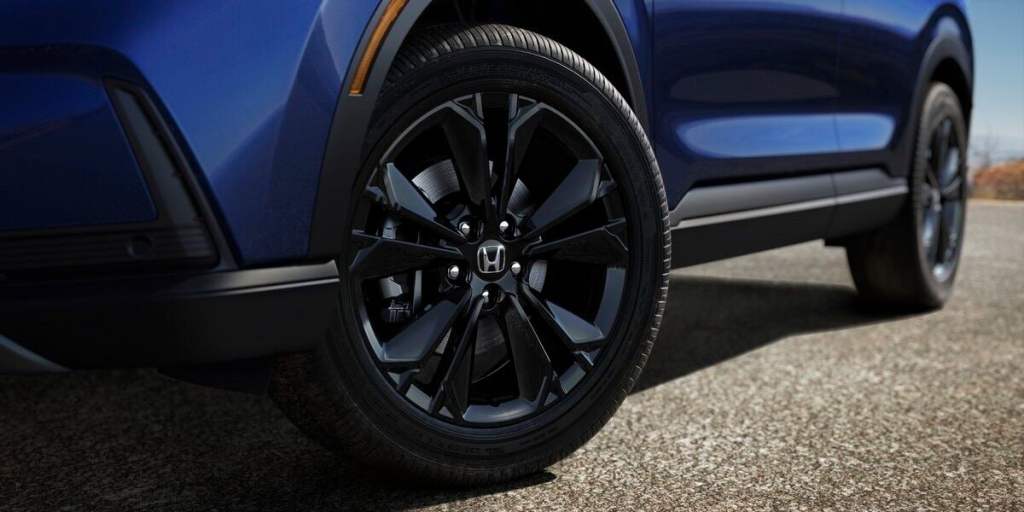Award-winning 2025 Honda CR-V is a Pacific Northwest favorite
Published 11:00 am Tuesday, April 15, 2025

- The Sport and Sport Touring version of the redesigned 2025 Honda CR-V comes standard with a hybrid engine and black treatments that helps them look both bold and sophisticated.
It’s easy for automotive writers to say the newest version of any vehicle is the best yet. That’s almost entirely true, although the downsized Big Three cars from Detroit in the 1980s were complete disasters. Not so the 2025 Honda CR-V, the newest version of one of the earliest compact crossovers that created the entire car-like SUV market. Every generation has arguably been the best available compact crossover SUV, and the newest version is, well, the best yet.
Trending
The result is the perfect small family hauler for the Pacific Northwest, with a surprising amount of interior room, a comfortable ride, and available Real Time All-Wheel-Drive for better traction in slippery conditions. The 2025 version is also available as a hybrid that has an even smoother ride and gets over 40 miles per gallon.
But don’t just take my word for it. Car and Driver magazine named the 2025 CR-V its 10Best list for 2025, the sixth time for that honor. Kelly Blue Book has also named it a Best Buy multiple times. The CR-V has also repeatedly been recognized by the Insurance Institute for Highway Safety (IIHS) as a Top Safety Pick+.
That’s even more impressive considering how many compact crossover SUVs have been introduced since the CR-V was first sold in America in 1997. At the time, it followed the Toyota RAV4 as only the second unibody SUV for sale in the country. The RAV4, introduced in 1995, was based on the popular Corolla compact, although it offered more interior room, greater ride height, larger cargo space, and available all-wheel-drive. The CR-V, which was based on the compact Civic, offered the same benefits and was slightly more refined.
Trending
Until then, SUVs were based on trucks. Even the smallest ones, like the Chevy S10 Blazer and Ford Bronco II, got worse mileage and did not ride as well. Since the RAV4 and CR-V were released, practically every other manufacturer has jumped in with their own models, many now with their own unibody chassis. But the CR-V, now in its sixth generation, has not only kept up but continuously topped the competition.
One secret to the CR-V’s success is its focus. Unlike several competitors, Honda does not offer a sporty or off-road version. It is focused on small families watching their wallets. And that is where it completely succeeds.
The non-hybrid version comes standard with a turbocharged 1.5-liter inline 4-cylinder engine that produces 190 horsepower and 179 pound-feet of torque. It is mated to a Continuously Variable Transmission and is available with front- or all-wheel drive. The base LX FWD version starts at $31,495 and the most expensive EX-L version begins at just $36,395, making it affordable to virtual anyone.
The Hybrid version costs more, but not by all that much, considering it packs a bigger gas engine, two electric motors, a battery pack, and is only available on upper trim levels. The 2.0-liter engine and dual motors are rated at 204 horsepower and 247 pound-feet of torque. Power is delivered through a direct-drive set up. Prices range from $36,045 for the base Sport to $42,495 for the lowest-priced Sport Touring version.
The higher prices for the Hybrid version will be easily offset by the fuel savings after a few years. The EPA rates the gas-only CR-V as up to 28 miles per gallon in the city and 34 on the freeway, which is very good for any SUV. But the Hybrid easily tops that with EPA ratings of up to 43 city and 36 highway.
The additional power and higher mileage is not the only reason to consider the Hybrid versions, however. The ride is much smoother, even when the gas engine comes on to boost the total power when accelerating. That is because Honda uses a unique hybrid system with two electric motors. One motor functions as a generator, and the other propels the car. The gas engine charges the battery and only assists in powering the vehicle when needed.
As a result, the power ebbs and flows as effortlessly as an all-electric vehicle, making even driving in urban traffic vibration free. It’s a remarkable achievement that extends to Honda’s other hybrid vehicle with the same design, including the compact Civic and mid-size Accord sedans.
It’s also worth noting that the CR-V uses a physical drive shaft connected to the rear wheels for AWD models. Most other hybrid SUVs add a third motor in the back.
Every 2023 CR-V is equipped with a long list of driver-assistance technology. Along with newly standard blind-spot monitoring, they now come with a driver-attention monitor, traffic-sign recognition, and a back-seat reminder. Other standard safety features include: forward-collision warning and automated emergency braking; lane-keeping assist and lane-departure warning; and adaptive cruise control
My tester was the top-of-the-line Sport Touring version, which included the highest interior trim and most advanced technologies. Despite that, the dash design could best be described as functional, with a lot of soft plastics accented by a horizontal mesh strip that masks the AC vents. The relatively small upright center display lags behind the dash-wide screens being offered by many competitors. All necessary information was still easily available, but the look was not the most modern, if that’s important to you. I personally appreciated the traditional shift lever and physical temperature control knob that were easy to find and use.
The CR-V came with four drive modes. Eco is normally the slowest in any vehicle because the throttle response is decreased to save fuel in gas-only vehicles and the engine does not come on as often in hybrids. But the Eco mode in the CR-V was surprisingly pleasant to drive, while also being most quiet. Normal was only a little quicker while also being slightly noisier, but not enough to be a bother. Sport was the fastest but also the loudest because the engine comes on more. I didn’t have chance to test the Snow mode because it was early Spring, but I’m sure it makes the optional AWD system even more useful in winter months
The CR-V was last redesigned in 2023, when it because the largest and boxiest version since it was first introduced, resulting in the most interior room and cargo space. There have been few significant changes since then. The fact that it is still winning awards proves how good the current generation still is. As Kelly Blue Book said when it named the 2025 Honda CR-V the Best Compact SUV, “Not only is the Honda CR-V wonderfully practical, utterly dependable, and fuel-efficient, but it’s also quite satisfying to drive.”
2025 Honda CR-V
Base price: $31,110 (31,495 FWD)
Price as tested: $42,150 (AWD Sport Touring)
Type: Compact crossover SUV
Engines: 1.5-liter 4 (190 hp, 179 lbs-ft); 2.0-liter inline 4, dual electric motors (204 hp, 247 lbs-ft – as tested)
Transmission: Continuously Variable Transmission; Direct-drive (Hybrid)
Drive modes: Eco, Normal, Sport, Snow
EPA estimated mileage: 28/35 (Turbo FWD); 40/36 (Hybrid FWD); 40/34 (Hybrid AWD – as tested)
Overall length: 184.8 inches
Curb weight: 3914 pounds
Final assembly: Alliston, Ontario, Canada







